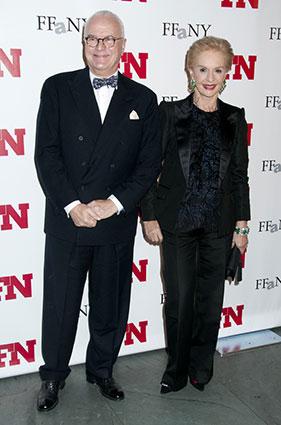
Manolo Blahnik (b. 1942) was a designer and manufacturer of what were called "the sexiest shoes in the world"-beautiful, expensive, and highly coveted by many of the world's most fashionable women. Heir to a tradition of luxury shoemaking epitomized by André Perugia, Salvatore Ferragamo, and Roger Vivier, Blahnik produced shoes-"Manolos," to the cognoscenti- that became icons of the fashion culture at the turn of the twenty-first century. In the words of retailer Jeffrey Kalinsky, "There's never been a shoe designer whose reign as No. 1 shoe designer has lasted so long. His hold on the throne has no sign of doing anything but growing" (Larson, p. 6).
Manolo Blahnik Biography
Manolo Blahnik was born on 27 November 1942 in the small village of Santa Cruz de la Palma in the Canary Islands, where his family-his Spanish mother, Manuela, his Czechoslovakian father, Enan, and his younger sister, Evangelina-had a banana plantation. Manuela, a voracious consumer of fashion magazines, bought clothes on shopping trips to Paris and Madrid and had the island's dressmaker copy styles from fashion magazines. She designed her own shoes with the help of the local cobbler.
Manolo Blahnik moved to Geneva at the age of fifteen to live with his father's cousin. Here he had his first experiences of the theater, opera, and fine restaurants. He studied law for a short period but soon switched to literature and art history. Blahnik left Geneva for Paris in 1965 to study art and theater design. He worked at the trendy Left Bank shop GO, where he met the actress Anouk Aimée and the jewelry designer Paloma Picasso.
With Picasso's encouragement, Blahnik soon moved to London. While working at Feathers, a trendy boutique, he continued to cultivate his connections to the worlds of fashion and culture and was known for his unique style. But Blahnik was still searching for a specific vocation; the search then took him to New York City.
Manolo in NYC
Blahnik arrived in New York City in 1969. Hired by the store Zapata, he began designing men's saddle shoes. In 1972 Blahnik was introduced to Ossie Clark, then one of London's most fashionable designers, who asked him to design the shoes for his women's collection. While the shoes were not commercially successful, the press noticed their originality of design. Blahnik had no formal training as a shoemaker and initally his designs were structually weak. He consulted with a London shoe manufacture in order to correct his lack of technical skills. Also during this time Blahnik met Diana Vreeland, who declared, "Young man, do things, do accessories. Do shoes" (McDowell, p. 84). This endorsement was seconded by China Machado, the fashion editor of Harper's Bazaar. Women's Wear Daily proclaimed Blahnik "one of the most exotic spirits in London" in 1973, and Footwear News described the Manolo Blahnik shoe on its front page as "the most talked about shoe in London." Blahnik purchased Zapata from its owner in 1973. In 1978 he introduced a line exclusive to Bloomingdale's, a well-known American retailer. Blahnik opened a second free-standing store a year later on New York's Madison Avenue.
Blahnik's creations received considerable publicity in the early 1980s, but his business was not running smoothly. Searching for alternatives, he was introduced by Dawn Mello, the vice president of Bergdorf Goodman, to an advertising copywriter named George Malkemus. Malkemus and his partner, Anthony Yurgaitis, went into business with Blahnik in 1982. They closed the Madison Avenue shop, opened a store on West Fifty-Fourth Street, and limited the distribution of Blahnik's shoes to such prestigious retailers as Barneys, Bergdorf Goodman, and Neiman Marcus. By 1984 the newspaper USA Today projected earnings of a million dollars for the New York shop alone. Manolo Blahnik shoes began to appear on the runways of designers from Yves Saint Laurent, Bill Blass, and Geoffrey Beene to Perry Ellis, Calvin Klein, Isaac Mizrahi, and John Galliano.
Manolo Blahnik's shoes became more popular than ever in the early twenty-first century. They appealed to an increasingly broad audience, in part because of their star billing on the television show Sex and the City. With production of "Manolos" limited to 10,000 to 15,000 pairs per month by four factories outside of Milan, the demand for these shoes exceeded the supply.
Excellence in Design
Manolo Blahnik won three awards from the Council of Fashion Designers of America in the 1980s and 1990s. The first special award was given in 1987; the second, for outstanding excellence in accessory design, in 1990. The third award came with the following tribute in 1997: "Blahnik has done for footwear what Worth did for the couture, making slippers into objects of desire, collectibles for women for whom Barbies are too girlish and Ferraris not girlish enough …. an incredible piston in the engine of fashion, there is almost no designer he has not collaborated with, no designer who has not turned to him to transform a collection into a concert."
The December 2003 issue of Footwear News quoted Alice Rawsthorn, the director of London's Design Museum, which had been the site of a recent Blahnik retrospective: "Technically, aesthetically and conceptually, he is one of the most accomplished designers of our time in any field, and is undeniably the world's most influential footwear designer" (Anniss, p. 16).
See also Ossie Clark; Salvatore Ferragamo; London Fashion; Women's Shoes; Diana Vreeland.
Bibliography
Anniss, Elisa. "Prince Charming." Footwear News, 8 December 2003.
Larson, Kirsten. "Blahnik Holds Reins Tight on His Manolos." Footwear News, 10 November 2003.
McDowell, Colin. Manolo Blahnik. New York: HarperCollins, 2000.
Reed, Julia. "Walk This Way." Vogue, November 2003.







